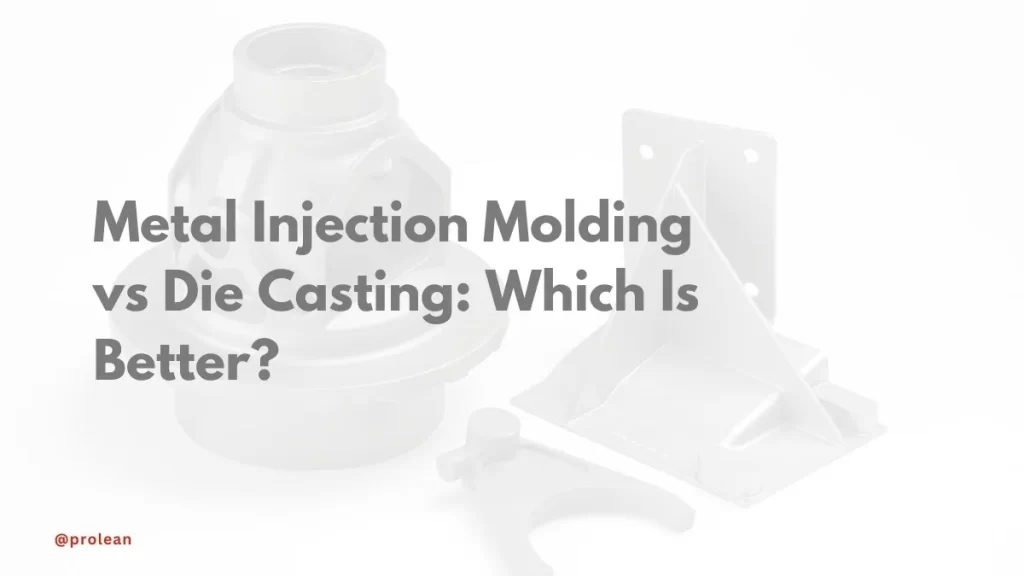
Choosing between metal injection molding vs. die casting is a critical decision. Metal Injection Molding is a more complicated process, which goes through several steps to create parts, and therefore is suitable for producing numerous small and intricate parts.
On the other hand, die casting takes fewer steps and is cheaper for both low- and high-volume production than the MIM process.
The two methods, MIM and die casting involve high initial setup and automation thus, it is crucial to have correct knowledge of its processes and final output before selecting the most suitable one.
Background of MIM
The metal injection molding-MIM process was discovered in the 1970s by Raymond Welch. The method forms metal components, as with the plastic injection molding process. The major difference in MIM implies that the metal powder is combined with a thermoplastic binder that is subsequently removed. On the other hand, plastic injection molding incorporates additives like glass or ceramic fibers right through the process. The metal/binder is further fed into an injection molding barrel. The intended barrel has a screw with a continually enlarging shank. As the screw rotates the powder fills up compacter spaces gradually.
The pressure produced by the screw mainly causes heat which melts the plastic binder containing the metal powder. Furthermore, the barrel is made to be heated for extra energy production. After a sufficient quantity of material melts, the screw reciprocates and drives the melt into a two-cavity mold which is kept filled during the injection.
Afterwards, when the mixture is cool the green part is skimmed off. To obtain final characteristics, the binder is removed leaving behind pores which are then eliminated by sintering leading to a fully dense component. This green part is exposed to solvents or catalysts and then heated to burn off the binder and turn the part brown. Last but not least, the part is sintered to reduce its volume by 15-30% depending on the material of the part.
Try Prolean Now!
The Metal Injection Molding-MIM Process
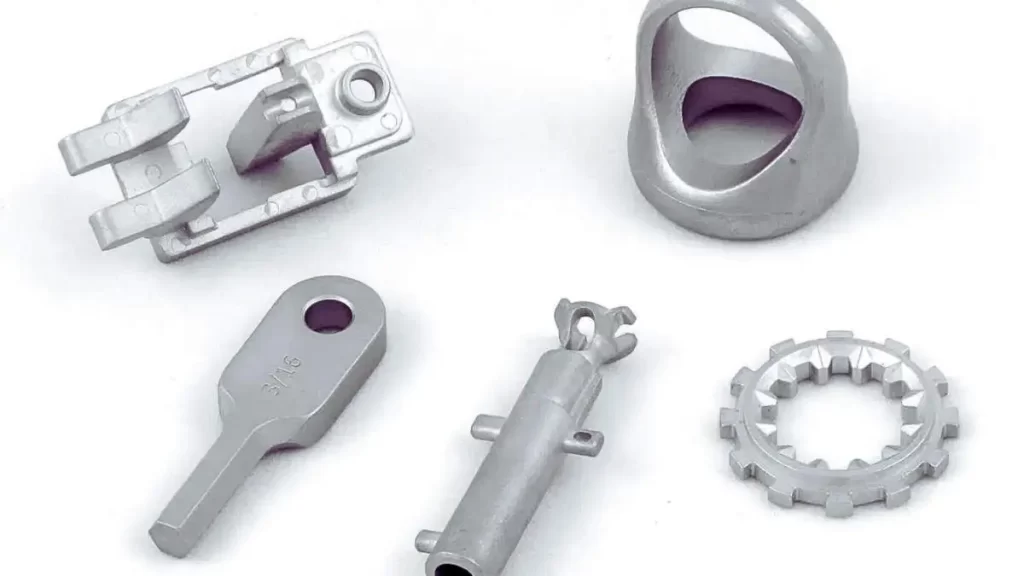
MIM parts
When comparing metal injection molding vs. die casting, the MIM process is comparatively more detailed.
First, a metal powder of the base alloy is produced and then mixed with a thermoplastic binder to obtain a feed material. This is a processing aid binder used during the injection molding process but has to be debonded from the end product. The properties of the final part are exclusively dependent on the metal powder nature of the final part.
Moreover, It has been observed that during the mixing phase of the process, both the binder and the metal powder are heated. The feedstock can be prepared in-house, or bought as semi-finished for molding.
Then, the feedstock is injected into a mold, using an injection molding machine. After it is formed, the piece is called a “green” part. MIM has much in common with the process of plastic injection molding, so the creation of the parts with the same setting is possible. In molding, the part cools and then is ejected out of the mold. These parts are further examined for defects. The following step is de-binding. Generally, it uses a catalyst, solvent, and thermal furnaces. This in turn has the benefit of eliminating the thermoplastic binder while maintaining part structure. Sometimes, traces of the binder may be left behind and even these can disappear through the part’s porous structure.
Lastly, the part is heated to a sintering temperature to join the particles together and form a strong net shape. In the process of sintering the size of the part may decrease in volume from 15% to 30%. Moreover, the MIM parts can be heat or surface-treated to other desired standards depending on their use. Due to the versatility of the designs and the net-shape production capability, MIM is widely accepted in many industries.
Die Casting Background
The die casting process involves making different forms of metal parts where molten metal is forced into a mold. It was first used in 1838 and was patented later in 1849. The first metals that were used were lead and tin which were later changed to include aluminum and zinc by 1914. At present, magnesium, copper, and silicon are employed. Die casting is typically limited to non-ferrous metals although ferrous metals can be used sparingly.
The molten metal can also be forced/pumped in under high pressure or it can be fed in by gravity. The part is then ejected after cooling, a process that may take anything between 30 seconds to one minute depending on the size and thickness of the part. Any webs from gates, runners, and parting lines must be trimmed off and can be done by hand or with the use of press dies.
Die Casting Process
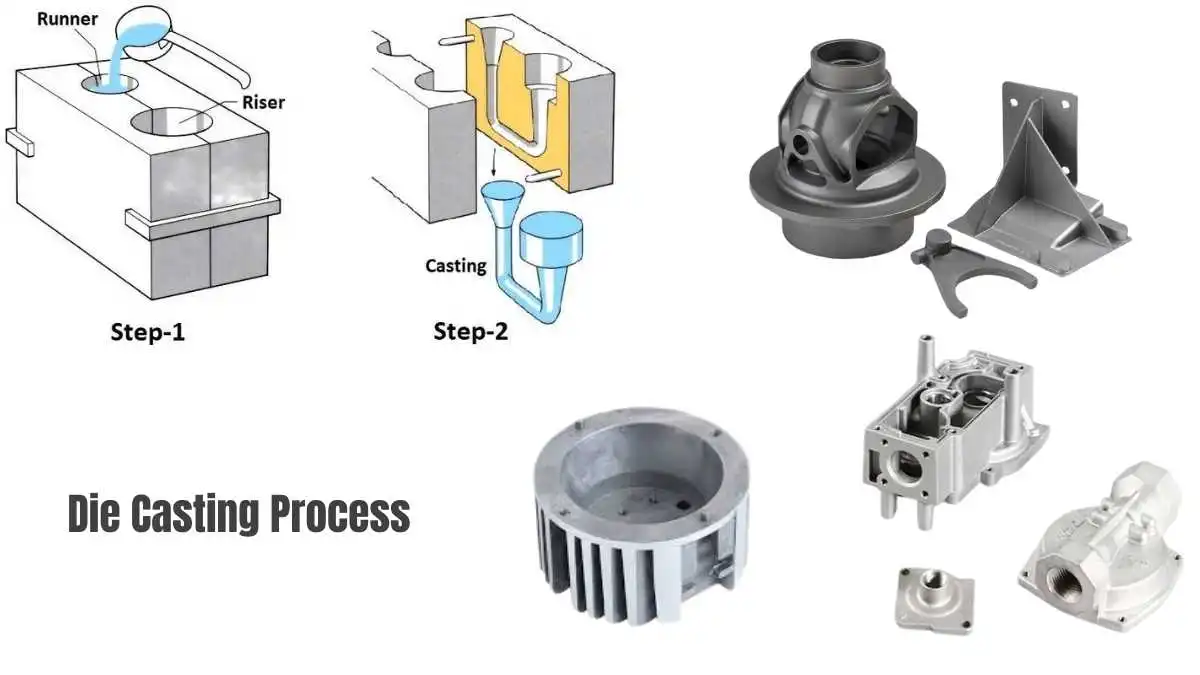
Die casting process
The die casting services originated nearly 200 years ago. Most of the techniques used today follow a similar concept. Although certain industries may incorporate additional steps to fulfill specific manufacturing requirements, the following stages remain consistent:
- Clamping: First, the dies are washed. After, they are closed tightly to prevent them from opening during the operation. Lubrication is used to avoid sticking and to control the temperature inside the die.
- Injection: Pressure is applied on the die by injecting molten metal at a pressure that ranges from as low as 20,000 psi to as high as 31,000 psi depending on the casting type being used, hot or cold chamber casting. The time of injection can change with the type of die used and the desired thickness of the wall on the part. Dies that feature multiple patterns on the external surface, and contain complex internal structures take longer to fill typically.
- Cooling: Cooling starts as soon as the molten metal fills the dies. The metal starts freezing up as it fills the die cavity. The part geometry and thickness are the key factors that determine the time that the part takes to cool.
- Ejection: After sufficient cooling, the two halves of the die are open and the finished part is expelled out. The process is then prepared to do the same for the next cast part.
- Trimming: All such metal and flash as may be left must be trimmed off, by hand. Trimming can also be done by using a second die.
Metal Injection Molding vs. Die Casting: Running Costs
The operational cost of a die-casting machine is significantly less than that of a metal injection molding (MIM) machine.
Die casting operating expenses are usually a few thousand dollars, while MIM machine costs may range into tens of thousands of dollars. The cost of MIM processes and machinery are inherently more due to complicated parts formation than other metal casting processes. Also, die-casting machines are comparatively heavier and are less likely to have problems that would need fixing. This makes them more efficient in many cases to run longer compared to MIM machines, further improving cost benefits.
Try Prolean Now!
Metal Injection Molding Advantages and Disadvantages
The MIM process is optimal for the production of small and complex components with intricate geometries using techniques from conventional injection molding. Nonetheless, die casting tends to offer difficulty in achieving thin features. In MIM only high temperature is used during sintering and no molten metal is involved, the high-melting-temperature materials can be used without any processing complications.
Cons of MIM include the fact that equipment is costly due to complicated tooling. MIM molds are generally expected to have a shorter life span than those used in die-casting because metal powder is abrasive. Also, MIM requires several post-molding processes, which are not only time-consuming but also raise the general cost of manufacturing. Secondly, large levels of shrinkage during the densification process require enhanced mold design to match highly specific dimensional requirements.
Die Casting Pros & Cons
As for the molds used in die casting and MIM, the former’s molds are longer in service compared to the latter’s. Die-casting mold can manufacture up to one million parts while MIM mold can only manufacture a few parts of up to a few hundred thousand parts. Compared to MIM products, die-cast products are not likely to shrink. This makes mold-making to the needed size easier.
Die casting is typically limited to nonferrous metals. However, ferrous metals such as steel are used in casting, but the high melting point of these materials will greatly reduce the number of times a mold can be used. Also, high-pressure core-making causes gases to be trapped, creating porosity, and reducing the mechanical properties of the part. MIM parts generally have much lower porosity which is advantageous to its mechanical properties.
Comparison Table: Metal Injection Molding vs. Die Casting
Table: Attributes of Metal Injection Molding and Die Casting
| Attribute | Metal Injection Molding | Die Casting |
| Ferrous Metals Processing | Yes | Rarely |
| Wall Thickness Range | 0.040” to 0.120” | 0.04” to 0.2” |
| Cost-Effective Production | No | Yes |
| Complexity of Process | Multi-step | Single-step |
| Material Compatibility | Tungsten, Stainless steel, Tool steel, Cemented carbides, Nickel alloys, and precious metals. | Aluminum, Zinc, Copper, Magnesium, Lead, Pewter, Tin |
More Comparison of MIM and Die Casting
- Cost Effectiveness: Both require high respective volumes for optimum mold cost. Die casting is usually 30% cheaper due to fewer processes that are required after production.
- Production Speed: The MIM molding phase is faster than die casting. However, extra post-processing prolongs the total manufacturing time of MIM.
- Production Volume: MIM and die casting both are suitable in high volume production. MIM is most useful in the creation of complex and small parts while die casting is suitable when making complicated and large parts.
- Material Usage: Die casting is applicable for only non-ferrous materials such as aluminium die casting, zinc, and magnesium casting. While, MIM deals with ferrous as well as nonferrous metals, and some other special materials like titanium and nickel alloys whereas stainless steel is the most commonly used material in the MIM process.
Try Prolean Now!
Final Thoughts
The choice between metal injection molding vs. die casting primarily depends on project needs and intended application. There are several important considerations; for instance; part complexity, part size for manufacturing, material type being used, the quantity produced per cycle or run, and the overall cost of the part. However, each method can be complex to understand. Don’t worry! Prolean is professional and committed to the quality of its products, which employs professional and sophisticated equipment to provide premium injection molding service as per the customer’s needs.

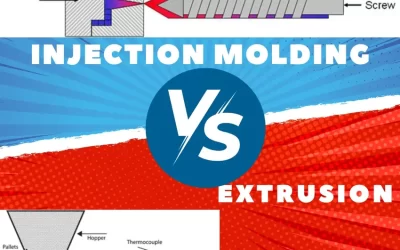
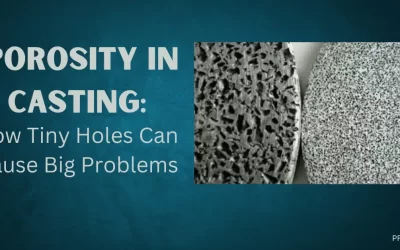
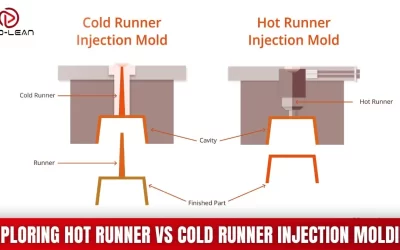
0 Comments